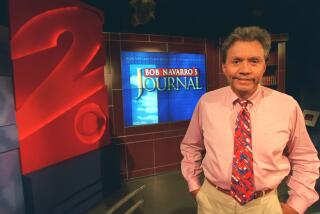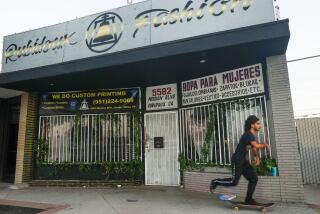Review: Ruben Salazar documentary; a life in the midst of the news
Ruben Salazar, who wrote for the Los Angeles Times from 1959 until his death in 1970, when he was shot with a tear gas shell as he sat in an East Los Angeles bar while a demonstration became a riot outside, is the subject of a new documentary, “Ruben Salazar: Man in the Middle.” It premieres Tuesday on PBS as a presentation of the Latino showcase “Voces.”
Directed by Phillip Rodriguez (“Race 2012”), the film is an efficient and enlightening, if at times frustrating, primer on a man whose life is as little known as his name might be familiar and whose death clouded that life in legend, conspiracy theories and the distorting mist of martyrdom. Newspaper-reading Angelenos of a certain age would know him, certainly, but he was profiled in Newsweek in his lifetime, as well, and has had his face on a U.S. postage stamp.
Nevertheless, and notwithstanding a stint as a foreign correspondent, including work in Vietnam, the Dominican Republic and Mexico, where he ran The Times’ Mexico City bureau, and for all the wider implications of the stories he tackled at home — and the file the FBI ran on him — he was very much a local reporter. And though he covered many kinds of stories in his career, the work he’s remembered for has everything to do with being Latino in Los Angeles in a transitional, radicalizing time and therefore concerns the LAPD and the county sheriffs, in whose side he was increasingly a thorn.
PHOTOS: Behind the scenes of movies and TV
As framed here and told by friends, family and colleagues and with his own words — from The Times, TV interviews and in unpublished personal writing — Salazar’s story is very much one of his coming to terms with his Mexican heritage and community. Indeed, he seems to have died as a work in progress.
Born in Ciudad Juárez, Mexico, in 1928, he was raised in El Paso by a social-striving mother (and less forceful father). She “had good taste in material things,” Salazar remembered, “and ruthless dogmatism in personal relations; brought up in the caste system of Mexico, she assigned a fanatical importance to being white.”
It was the beginning of a sort of self-canceling doubleness that continued to trouble him: “This has been the dilemma of my life,” he wrote in a journal. “This has made me lonely, unadjustable and in a way lost.” Elsewhere he wrote, “There’s no such thing as a real Mexican-American. The hyphen strips both words of meaning.”
He was, at least at first, the newsroom’s lone Latino. He commuted from Orange County, where he lived what might be called an Anglo existence with his white wife and their kids. “Sally pointed out to me as we lay in bed in the dark the other night that our two month old daughter will not have it easy in life; she’s going to miss a lot of things because of her name .... I didn’t say anything .... Why do I always have to apologize to Americans for Mexicans and to Mexicans for Americans?”
BEST TV OF 2013 Lloyd | McNamara
But fate and the times made this his subject. Recalled from Mexico City — because he missed an important story, it’s suggested, and a change Salazar found “professionally defeating and distressing personally” — he was given the job of covering L.A.’s Latino community just as Los Angeles, in the words of fellow reporter Bill Drummond, had become “a very, very agitated place” with “a pattern of deaths that had happened as a result of police abuse.”
Simultaneously, the Chicano power movement was coming into being. (One of the best things about “Man in the Middle” is that it reminds us that there was such a thing.) Salazar was both affected by it and, as a good reporter, skeptical of some of its leaders and wary of being used by them. Early in 1970 he left The Times to run the news department at the Spanish-language UHF station, KMEX, Channel 34, but continued to write a weekly column for the paper; his writing grew more personal and politicized.
Salazar’s death, coming as it did on the day of the Chicano Moratorium — a national protest against the disproportionate number of Latino dead in Vietnam, that in Los Angeles had, through a then-familiar mix of incidental provocation and violent official overreaction, turned into a riot — inescapably became a political moment itself. Some suspected murder. Salazar had written about police pressuring him to stay away from stories that might be “dangerous in the minds of barrio people.”
Though Rodriguez’s film is arranged, sometimes a little disingenuously, as if to promise some sort of big revelation, none is forthcoming. He interviews the mysterious Man in the Red Vest, who told police a man with a gun had gone into the Silver Dollar Cafe, and Tom Wilson, the deputy who shot the canister that killed Salazar, but neither has anything of substance to say.
Photographs that seem to portray police spies are displayed, without corroboration. And though the filmmakers were instrumental in getting long-sealed case files released, they lead back to the old official conclusions, that mistakes were made and no crime committed.
“After all this,” says Salazar’s daughter Stephanie Salazar Cook, “it was just ineptness, or accident, or overzealousness? That’s sad, that’s so sad.”
------------
‘Ruben Salazar: Man in the Middle’
Where: KOCE
When: 9 p.m. Tuesday
Rating: TV-PG (may be unsuitable for young children)
More to Read
The complete guide to home viewing
Get Screen Gab for everything about the TV shows and streaming movies everyone’s talking about.
You may occasionally receive promotional content from the Los Angeles Times.







